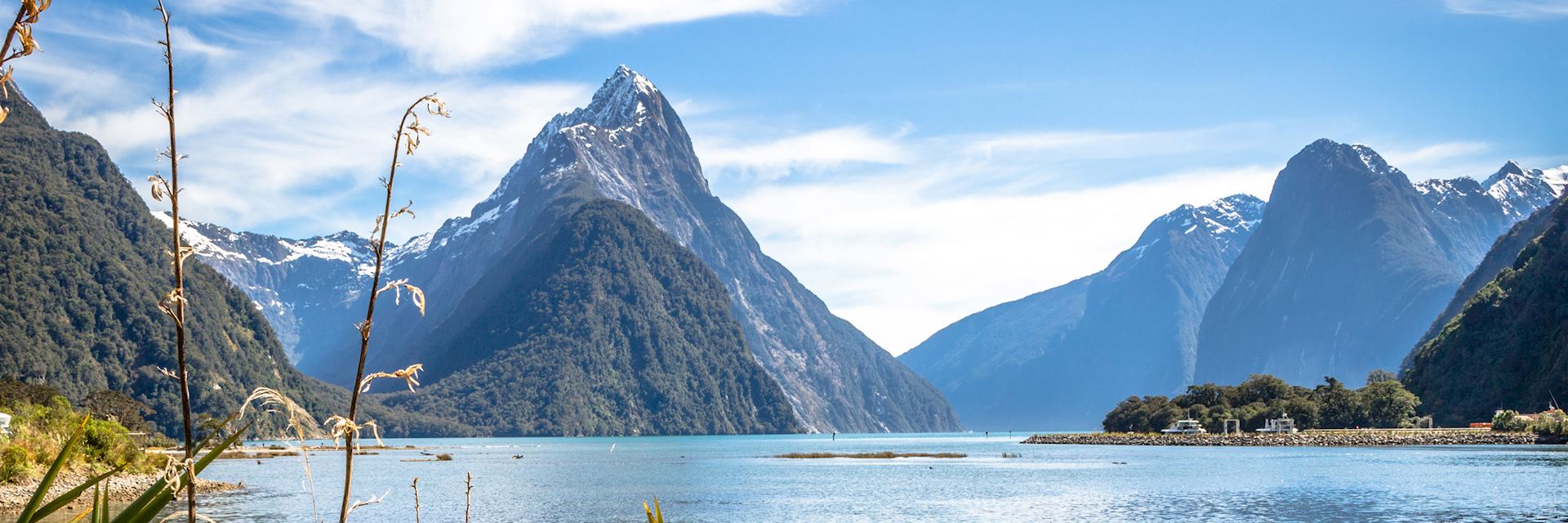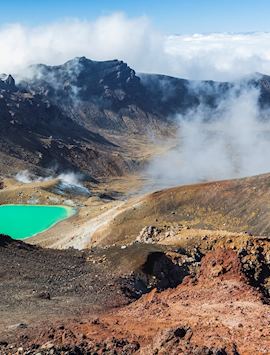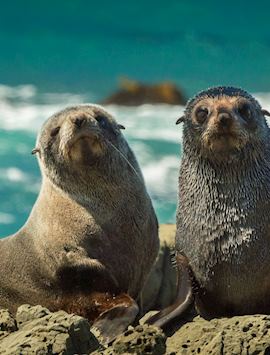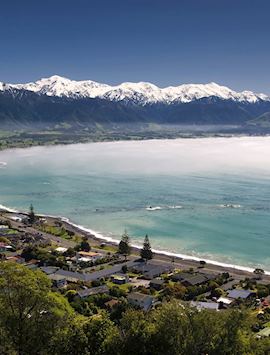By New Zealand specialist Linzi
New Zealand has long been a favourite destination for lovers of the great outdoors and, having lived in this magical country, I appreciate why.
Mountainous landscapes are dotted with lakes and vineyards. The coastline offers great beaches where you can relax or try out a host of water sports and take boat trips to spot whales, dolphins and incredible birdlife. It’s also an easy country to travel round with welcoming people, compact cities and rich Māori culture.
What to do on North Island
Cruise the Bay of Islands

On the northeast coast of New Zealand, 144 islands make up the Bay of Islands. It's an area of countless coves, and the best way to explore and appreciate the contrast between the rolling green farmland on the islands and the deep blue Pacific is to take a cruise.
The marine life is exceptional, and you may spot whales, dolphins and seals. The cruises also bring to life Māori folklore and on a calm day you can sail into the ‘Hole in the Rock’ where it’s believed you’ll be blessed with good luck should water fall on you from the rocks above.
Russell is the starting point for exploration of the Bay of Islands. Once a key whaling station, Russell now has a relaxed, colonial charm. Close by is Waitangi, where the Treaty of Waitangi was signed by the Māori and British in 1840, marking the birth of New Zealand.
Take a wine tour of Waiheke Island

New Zealand’s well-known wine regions, such as Napier and Hawke’s Bay on the North Island and Marlborough on the South Island, are all wonderful to visit, but the country has vineyards in most areas and there are some delightful, niche producers that you can visit too.
A short ferry ride from Auckland, Waiheke Island is a great retreat from the city and I’d highly recommend a couple of days here after a long flight.
Combine time strolling or sunbathing on the white-sand beaches with a tour of one of the twelve or so vineyards, where you can also sample some fantastic cuisine sourced from the island’s organic farms. Lunch at one of the coastal vineyards, which has a view over Auckland is a real treat.
For a traditional French chateau feel, head to Mudbrick Estate. For a modern twist, I’d recommend Cable Bay.
Get into hot water in the Coromandel Peninsula

Standing at the edge of the Pacific Ocean, on one of the Coromandel Peninsula’s golden beaches, it’s difficult to believe you’re close to Auckland, given how remote it feels. The coast has rocky shorelines and picturesque beaches whilst the volcanic hills inland are home to thick rainforest. At Hot Water Beach, named because of the thermal activity there, you can dig a hole in the sand, watch it fill with bath-warm water and relax in your self-made pool.
Cathedral Cove is another worthwhile spot to explore. A half hour or so walk from the nearest car park takes you to golden sands framed by a huge arched cavern. Boat trips around Cathedral Cove provide further vantage points.
Join Kiwi Dundee on a tour of the Coromandel Peninsula

One of the most entertaining days I’ve spent in New Zealand was on the Kiwi Dundee ‘Bush and Beach’ Tour. Kiwi Dundee is a local man in his seventies who grew up on the Coromandel Peninsula. Despite the tongue in cheek name of his company, he gives an entertaining and insightful tour of the area, which has won awards from the likes of National Geographic.
With his wife, Jan, Kiwi Dundee skilfully adapts his tours to the group, with a full day generally taking in Hot Water Beach, old hidden mines, a forest walk and an exploration of the local Māori culture.
Kiwi Dundee has a mischievous sense of humour, which isn’t always for the faint-hearted. At one point he led our small group into a dark cave and when he switched on his torch I was inches from a wall full of ‘wetas’ (large cricket-like insects).
Geothermal activity in Rotorua
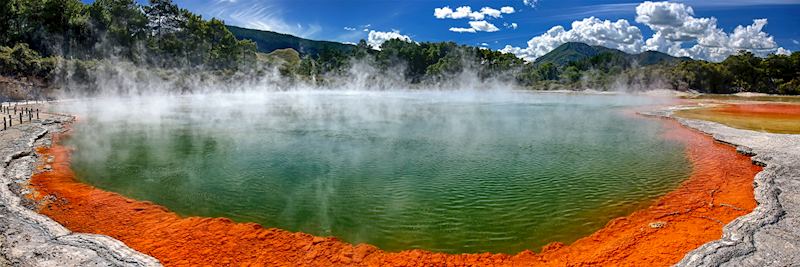
Well known for its geothermal activity, the Rotorua area has many thermal parks with bubbling mud pools, geysers and mineral lakes. Wai-O-Tapu has the most famous geyser and other parks have luxurious spas.
Rotorua is a centre for Māori culture, some of which is more commercialised than you might like, but the Māoris originally settled here to make use of the environment for cooking and warm water. It takes a while to get used to the smell of sulphur in Rotorua, and to walking down the street to find steam drifting up from the ground!
What to do on South Island
Seeing whales and dolphins in Kaikoura

At Kaikoura the position of the continental shelf forces cold, nutrient-rich water quickly upwards and creates optimal feeding conditions for many marine animals including sperm whales, which can be seen year round. More than 95% of the whale-watching boat trips here result in whale sightings. As well as sperm whales you might see pilot, southern right, blue and humpback whales, not to mention the largest members of the dolphin family, orcas.
I’ve swum with dolphins many times in different parts of the world, but my favourite experience was in Kaikoura with dusky dolphins. On my half day boat trip we saw pods more than a hundred strong, and in the water I was surrounded by at least 20 to 30 dolphins swimming right up to and around me.
Raise your adrenaline levels around Queenstown
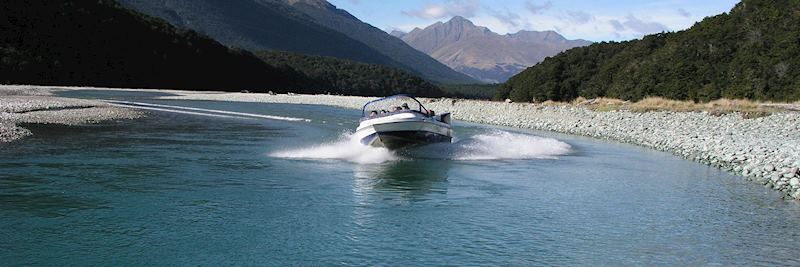
The rugged Remarkables Mountain Range meets Lake Wakatipu at Queenstown, giving the town incredible views at every turn. The landscape has allowed the resort to become the adventure capital of New Zealand. Adrenaline seekers can pick from jet boating, white-water rafting, kayaking, bungee jumping and parasailing. More relaxed ways to enjoy the setting include horse riding, walking, taking the mountain gondola and exploring the lake by steamship.
A short distance from Queenstown, the area around Glenorchy is famous for being one of the settings for the Lord of the Rings and Hobbit trilogies. My favourite way to experience the often snow-capped mountains and mirror lakes is on a Dart River Safari, a jet boat ride that speeds and spins along the river.
The more relaxing part of the experience was a bush walk through the forest eating ‘pepper leaves’ and passing through the one home stop of Paradise, encircled by more dramatic landscapes used in the films.
If you’re interested in kayaking it’s possible to extend the tour by a couple of hours and kayak through the narrow canyons and caves off the river.
Cruise through Doubtful Sound, Fiordland National Park

At the southern tip of the South Island, the peaks of Fiordland National Park rise steeply out of still waters. Penguins, seals and dolphins can all be seen in the unspoilt waterways, which are best explored by boat.
Though Milford Sound is relatively well-known and certainly beautiful, I personally prefer Doubtful Sound. Only one company runs cruises here so unless you come across a private charter your boat will be the only one you’ll see. On the ‘Sound of Silence’ experience, the boat’s engine is turned off and the passengers fall quiet so all you can hear is birdsong and tumbling waterfalls.
Fiordland National Park can be reached by coach from Queenstown in one very long day, but it’s more accessible from Te Anau.
If your budget allows there’s also the option of taking a helicopter trip over the sounds for a bird’s-eye view. You can stay the night on one of the boats, but the scenery is just as breathtaking on day trips.
Take in the scenery of Abel Tasman National Park

It’s difficult to escape impressive scenery in New Zealand, but if I were to choose a park you must see for its sheer beauty it would be Abel Tasman, the smallest and only coastal national park in the country, and within easy reach of Nelson, at the top of the South Island.
The golden sand beaches backed by limestone cliffs can be visited on foot or by sea kayak. Dolphins and seals are often seen in the clear waters whilst inland the hills are cloaked with native forest and peppered with caves to explore.
Walking in Mount Cook National Park
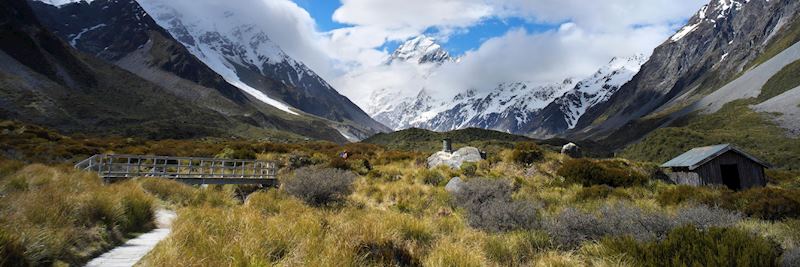
New Zealand has exceptional walking trails all over the country, but one of my favourite spots for ‘tramping’, as the locals call it, is Mount Cook National Park.
In 1998 the mountain of the same name reverted to its historic Māori name, Aoraki, meaning, appropriately ‘cloud piercer’. The triangular peaks provide a backdrop for everything from short, relatively easy walks to multi-day treks that will test your climbing skills and endurance levels.
A demanding, but recommended, five kilometre (three mile) hike from Mount Cook Village takes you to Mueller Hut from where the dramatic vistas include Mount Cook, Muller Glacier and Lake Pukaki. You'll be treading in the footsteps of Sir Edmund Hillary who prepared himself for his ascent of Mount Everest here.
For a more leisurely approach to admiring the scenery, I’d advise taking a scenic flight or ski plane. On a clear day the views from the air are unsurpassed and some trips land on Tasman Glacier.
Start planning your trip to New Zealand
Start thinking about your experience. These itineraries are simply suggestions for how you could enjoy some of the same experiences as our specialists. They’re just for inspiration, because your trip will be created around your particular tastes.
View All Tours in New ZealandFurther reading
- Best time to visit New Zealand
- New Zealand self-drive holidays: 3 great routes
- Cruising in New Zealand
- Family holidays in New Zealand
- 7 experiences to try on your outdoor activity holiday in New Zealand
- Ask the experts: where to go walking and trekking in New Zealand
- Where to go cycling in New Zealand (and why you’d want to)

